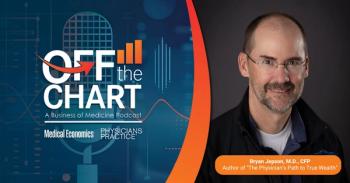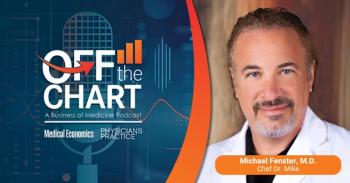
Noteworthy: Motivational Tips; Physician Fraudster; New Old Opportunities
Noteworthy items from Physicians Practice
Stat
20 The percentage of physicians who say they have not fully disclosed a medical error to a patient in the previous year due to fear of a malpractice lawsuit.
Source: Health Affairs
Quotables
"You almost need two languages, one that you use with your colleagues and a second vocabulary you use with your patients."
Paul D. Smith, MD, professor of family medicine, University of Wisconsin School of Medicine and Public Health
Source: American Medical News
"The notion that your needs for healthcare are best met by seeing a doctor a couple times a year is probably wrong. There is obvious value in knowing more."
Dr. Joseph Smith of the West Wireless Health Institute, which seeks to lower healthcare costs through technology like wireless medical devices.
Source: Marin Independent Journal
Motivational Tips
Practice Notes blogger and consultant P.J. Cloud-Moulds recently identified key ways to keep your staff happy and thriving. Start by creating a "strengths and opportunities" list for each employee. Then, "re-interview" each staff member and ask about their talents and special skills. Be sure to ask what they want to do that they are not currently doing. Then, review your original list of strengths and opportunities and consider whether staff members are serving in the right position, if they are assigned the right roles, if there is a special project you can offer them, etc. "There are gems hidden in all of us," says Cloud-Moulds. "Your staff needs you to be a treasure hunter for their skills."
Why Do You Stay?
Private practice certainly has its struggles, but that doesn't mean it has lost its allure. Physicians Practice recently polled our private-practice readers on why they opt-out of employment. Here's what they said:
• 45% Autonomy - I like to be my own boss and make the decisions
• 11% Comfort - This is all I know
• 34% Flexibility - I have more power over my own schedule
• 10% Culture - It's more laid back and family-friendly
5 Ways to Exploit Social Media
A robust social media network of professional colleagues can:
1. Shed light on new employment opportunities within your field;
2. Steer you toward nonclinical opportunities to pursue upon retiring, like consulting;
3. Help you identify opportunities for colleagues;
4. Expand your knowledge by exposing you to a wide range of links and talking points; and
5. Provide you with leads for a career transition.
Source: Internist and entrepreneur Joseph Kim, in a blog appearing on KevinMD.com
Advocacy to Action …
Talk about practicing what he preached. In March, a family physician killed himself by ingesting a lethal dose of medication, according to the Los Angeles Times. The 83-year-old physician, Peter Goodwin, had been diagnosed with a fatal brain disease in 2006. In January, he received a prognosis of less than six months to live, according to ABC News.
That made him eligible for physician-assisted suicide under Oregon's Death with Dignity Act - an act he himself advocated for in the 1990s. Implemented in 1997, the act was the first to allow physicians to prescribe lethal medication to terminally ill patients with a prognosis of less than six months. Goodwin joins a list of nearly 600 other terminally ill Oregonians who have purposefully ended their lives since the act's implementation.
… to Widespread Adoption?
In a timely coincidence, shortly after Goodwin's death two New Mexico-based physicians filed a lawsuit against that state's law prohibiting physicians from helping terminally ill patients die. The New Mexico physicians seek the ability to lawfully prescribe lethal medication to terminally ill patients who want it, according to Las Cruces Sun-News.
Physician Fraudster
A Dallas-area physician recently made headlines for allegedly masterminding the largest healthcare fraud scheme by a single physician practice ever. He and his co-conspirators are accused of working with hundreds of home health agencies to sign up new patients for home health services, according to NPR. Their patient recruitment tactics allegedly included buying groceries for people in exchange for their signatures, and parking at homeless shelters to get the homeless to sign up. Ultimately, over a six-year period ending in 2011, the physician and his colleagues certified more Medicare patients for home health services than any other practice in the country: 11,000 patients. Then, the physician allegedly submitted a staggering $374 million worth of false claims to Medicare and Medicaid for services to these patients.
New Old Opportunities
The physician shortage is becoming an old problem - literally. As the baby boomers age, it's critical that more geriatricians are available to treat them. That bodes well for physicians looking for a change. More and more geriatric training and fellowship programs are opening their doors to practicing physicians. Brown University for instance, offers psychiatrists a one-year geriatric fellowship training program; and some hospitals, like Boston Medical Center, offer weekend geriatric immersion programs for doctors, according to the New York Times.
Controversial Licensure Expansion
California may become the fifth state to allow nonphysicians to perform routine aspiration abortions. A state senator is proposing that nurse practitioners, nurse midwives, and physician assistants should be allowed to carry out the procedure during the first trimester of a patient's pregnancy, according to the Los Angeles Times. The senator says the role expansion will increase patient access to abortions, especially in rural areas. Oregon, Montana, Vermont, and New Hampshire all currently allow nonphysicians to handle the procedure.
Preemie Prevention
An innovative program may reduce the number of premature births and infant deaths in North Carolina. The Pregnancy Medical Home model, much like Patient-Centered Medical Homes, focuses on prevention and care coordination. Participating physicians receive incentives for taking extra steps to ensure smoother patient pregnancies, to include screening all pregnant Medicaid-eligible patients to see if they are at risk for complications, according to Stateline. When a patient is high-risk, a care coordinator is assigned to work with the patient to help her successfully navigate the pregnancy. According to the state's Medicaid director, the number of emergency room visits by pregnant women and usage of neonatal intensive care units have decreased since the program was implemented.
This article originally appeared in the May 2012 issue of Physicians Practice.
Newsletter
Optimize your practice with the Physicians Practice newsletter, offering management pearls, leadership tips, and business strategies tailored for practice administrators and physicians of any specialty.









